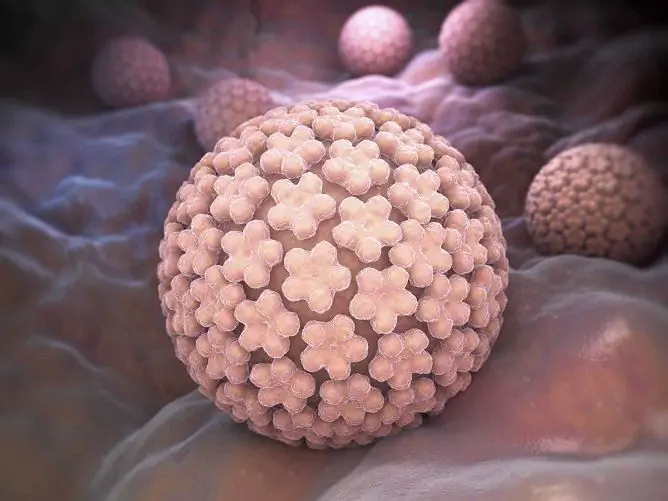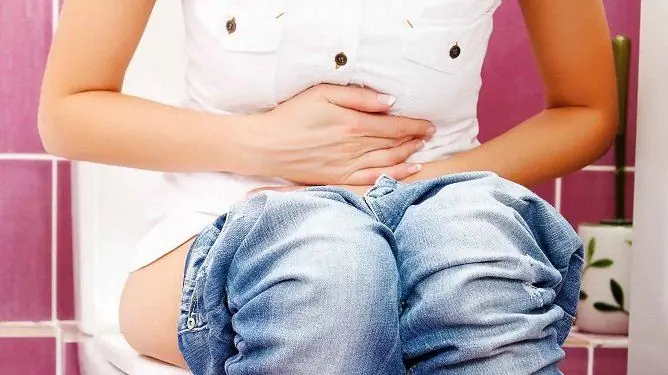- Author Rachel Wainwright [email protected].
- Public 2024-01-15 19:51.
- Last modified 2025-11-02 20:14.
Hot flashes with menopause
The content of the article:
- Why do hot flashes appear with menopause
- The mechanism of hot flashes with menopause
- Symptoms of hot flashes with menopause
-
Methods for treating hot flashes with menopause
- Taking hormonal drugs
- Alternative therapies
- Video
More than half of women with the approach and onset of menopause experience specific vegetative-vascular paroxysms - hot flashes, which can be characterized as a sudden wave of heat throughout the body, accompanied by profuse sweating, palpitations, and often - an increase in blood pressure. Hot flashes during menopause reduce emotional mood, impede concentration, and impair performance. Correction of such conditions is carried out depending on the severity and frequency of manifestations: the appointment of hormone replacement therapy (HRT), modification of the diet, lifestyle, the use of drugs, alternative to hormones.

Hot flashes are one of the most common unpleasant symptoms of menopause.
Why do hot flashes appear with menopause
Reduction or shutdown of the functional activity of the female gonads, leading to a persistent cessation of menstrual bleeding, is called menopause, or menopause. By persistent cessation, it is customary to mean the absence of menstruation throughout the year. Such changes in a woman's body can be natural and artificial.
Age-related depletion of the ovarian follicle reserve in the period from 45 to 55 years leads to menopause, called natural. Artificial menopause can be caused by:
- surgical removal of the ovaries;
- radiation exposure;
- taking medications.
In addition, menopause is distinguished premature, occurring before the 40-year mark. Its occurrence is associated with premature depletion of the follicular apparatus of the gonads, due to various etiological factors:
- hereditary predisposition;
- autoimmune processes;
- transferred viral infections;
- the influence of surgical, chemical, radioactive intervention.
In some cases, it is not possible to clearly establish the cause. A certain role is assigned to the toxic effects of the environment, tobacco smoking (more than 25-30 cigarettes per day), and starvation. But whatever the etiology of the process, the result is a lack of female sex hormones - estrogens. It is their lack that provokes unpleasant vasomotor symptoms - hot flashes.
The mechanism of hot flashes with menopause
It is believed that the lack of estrogen in the climacteric period affects the thermoregulatory center located in the diencephalon - the hypothalamus. When there is a decrease in the level of sex hormones in a woman's body, the concentration of estrogens reaching the brain also decreases, and the center of temperature regulation is deprived of the usual hormonal stimulation. Violation of its stable work is manifested by such reactions: excessive activation of heat transfer due to vasodilation and an increase in the intensity of sweating.
However, hot flashes occur not only as a result of endocrine changes, but also as a result of disturbances in the functioning of the autonomic part of the nervous system. Dysfunction of the autonomic nervous system is aggravated by a number of factors.
| Provoking factor | Negative impact |
|
Psycho-emotional stress |
Stress, anxiety, fear lead to cardiovascular neuroses. |
| Bad habits | Alcohol, smoking, abuse of spicy foods, caffeine, hot drinks increase vasomotor symptoms. |
| Hypodynamia | A sedentary lifestyle disrupts neuro-reflex connections, leads to maladjustment (inability to new conditions of existence) and the formation of chronic adrenal insufficiency. |
Understanding the pathophysiology of the process helps to effectively get rid of hot flashes during menopause.
Symptoms of hot flashes with menopause
Hot flashes that occur during the period of extinction of the hormonal function of the gonads are characterized by a varied spectrum and severity of symptoms.
| Characteristic | Description |
| Objective and subjective feelings |
A sudden wave of intense heat, spreading from the head to the neck, chest and further to the periphery; increased sweating, and more often - profuse sweating, followed by a feeling of shivering and chills at ebb. Frequent companions of the listed sensations are objective manifestations: increased heart rate, increased blood pressure, real redness and increased temperature of the skin in the face and upper chest. |
| Duration of an attack | A vegetative-vascular attack can last from 2-3 minutes to half an hour. |
| Period duration | How long the period accompanied by tides will last depends on many factors: heredity, age, concomitant diseases. In some patients, relief comes after a few months, in others, the problem has not been removed from the agenda for many years. On average, it takes 6 months to 2 years to experience discomfort, usually over time, the severity of symptoms gradually decreases. |
| Frequency | Vasomotor hot flashes can roll from several times a month to several times during the day. In most patients, characteristic sensations appear more often at night. |
| Expressiveness | The intensity of manifestations is very individual and does not always correlate with the duration of the attack. Often, short attacks are accompanied by sharp and significant sensations, and vice versa. The severity of hot flashes is influenced by the air temperature: in stuffy rooms, in the summer heat, negative manifestations are aggravated. |
Methods for treating hot flashes with menopause
It is necessary to deal with the vegetative-vascular manifestations of the pathological course of menopause, taking into account many factors:
- the age of the patient;
- duration of seizures;
- the frequency of paroxysms;
- severity of manifestations;
- the presence of concomitant diseases;
- individual drug tolerance.
You can effectively deal with hot flashes using a variety of methods.
Taking hormonal drugs
To alleviate the patient's condition, you can take hormonal drugs. To compensate for sex hormones that have stopped synthesizing the ovaries, the optimal doses of hormonal agents are used in various dosage forms:
- tablets;
- plasters;
- gels.
According to the patients' reviews, when using hormone replacement therapy, there is a significant decrease in the number and severity of hot flashes. Do not be afraid of the appointment of HRT, since modern medicines contain estrogens that are as close as possible in chemical structure to hormones synthesized in the female body, therefore:
- have minimal side effects;
- effectively remove the negative manifestations of menopause;
- prevent distant metabolic disorders;
- reduce the risk of malignant transformations, in particular, of the large intestine.
The use of drugs containing estrogens in combination with progestins - combination therapy, avoids hyperplastic processes in the uterine mucosa, they can be prescribed in two versions: cyclic and monophasic. The first provides for the preservation of bloody discharge like menstruation, the second - their absence, due to the transfer of the uterine mucosa to atrophic, which means an inactive state.
It is necessary to take hormonal drugs in any mode only on the advice of a specialist and under his supervision, since they have contraindications:
- hereditary predisposition to breast cancer, ovarian cancer;
- malignant diseases of the breast, ovaries, uterus;
- hormone-dependent cancer of any location;
- venous thromboembolism;
- severe liver dysfunction.
In some patients, as a result of taking hormones, it may occur:
- headache;
- excessive fluid retention;
- soreness of the mammary glands.
It should be noted that these symptoms usually bother women at first. They are leveled by reducing the dosage or changing the dosage form of the drug.
Alternative therapies
Despite a decrease in the frequency and severity of hot flashes in the vast majority of patients taking HRT, some women are unwilling or unable to drink hormonal drugs. What to do in this case? There is a way out - these are alternative types of therapy.
| Healing activities | Recommendations |
| Nutrition correction |
There is no strictly established diet for the pathological course of menopause. Nutrition during this period depends on many factors: body weight, metabolic rate, the state of the immune system, the presence of concomitant pathology, etc. The balance of the diet in terms of fat and carbohydrate components, the inclusion in the menu of foods containing the required amount of trace elements, vitamins - the basic principles of nutrition for women in this period. In the case of excess weight and its growth, a correction of calorie content is required by reducing the proportion of animal fats and simple carbohydrates. The proportion of vegetable fats and proteins is not subject to limitation. You should reduce the consumption of: fatty red meat, lard, bacon, offal, sausages, canned and smoked foods, fast food, sugar, cakes, jams, baked goods made from white flour. The diet must include foods that contain phytoestrogens. The latter are natural plant compounds that have a similar structure to female sex hormones and cause effects in the body similar to those of estrogens. They are found in soybeans, lentils, flax seeds, sesame seeds, barley, hops, red grapes, etc. |
| Rejection of bad habits | It is necessary to give up the use of strong alcohol, be sure to stop smoking. |
| Increased motor activity | With limited motor activity, or hypodynamia, muscle tone decreases, neuro-reflex connections are disrupted, the work of the nervous system and metabolism are discoordinated. Patients during the period of extinction of the hormonal function of the gonads need at least half an hour of physical activity every day in the form of walking, simple physical exercises, if possible, then classes in the gym. |
| Drinking regime | For normal functioning of organs and systems, you should drink a sufficient amount of liquid: from 1.5 to 2 liters per day. Preference should be given to water, green tea, fruit and vegetable juices. It is advisable to prepare juices immediately before use. |
| Water procedures | The severity of hot flashes can be reduced with water treatments. Douches, rubdowns, contrast showers, baths, swimming are very useful. |
| Non-hormonal drugs |
With moderate symptoms of vegetative-vascular tides, hormonal drugs can be dispensed with. Among the alternative pharmacological agents, herbal preparations and biologically active additives are most often used: Klimadinon, Klimadinon Uno, Remens, Klimaksan, Tsi-Klim, Estrovel, Bonisan, Inoklim, Feminal, etc. You should be aware that taking such funds does not give an instant result, they it is necessary to use it for a long time (2-3 months), if necessary - by repeated courses. A quick and effective effect can be obtained by taking preparations based on the amino acid beta-alanine (Klimalanin, Abyufen, Menshe). The active ingredient prevents hot flashes by saturating peripheral receptors, which leads to the expansion of skin vessels. In this case, the amino acid is completely different from the structure of the hormone and does not have antihistamine activity, although it effectively counteracts the rapid release of histamine. |

Mensa is one of the drugs that can help deal with hot flashes.
Using any method, even the most effective, will not bring lasting results. Only a complex of therapeutic measures will improve the quality of life of a woman during the period of extinction of the hormonal function of the ovaries and in postmenopause.
Normalizing weight, living a healthy lifestyle, and avoiding alcohol and cigarettes are essential conditions for well-being. A woman is able to do all this herself. Taking hormonal drugs with frequent and severe hot flashes is possible only after examination and consultation with a specialist.
Video
We offer for viewing a video on the topic of the article.

Anna Kozlova Medical journalist About the author
Education: Rostov State Medical University, specialty "General Medicine".
Found a mistake in the text? Select it and press Ctrl + Enter.






